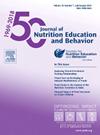复兴的时机已经成熟:北卡罗来纳州东北部农村的流动农产品市场试点
IF 2.3
3区 医学
Q2 EDUCATION, SCIENTIFIC DISCIPLINES
引用次数: 0
摘要
背景资源匮乏的农村社区在获得负担得起的健康食品方面面临系统性障碍。利用营养奖励计划(如代金券)的流动市场可能提供一种可持续的解决方案,但人们对其在农村地区的使用情况知之甚少。目的探讨利用代金券扩大“成熟为复兴”流动农产品市场在北卡罗来纳州东北部农村居民中的吸引力。研究设计,设置,参与者从2024年11月到2025年1月,研究人员使用客户拦截设计调查成熟的复兴移动市场成年客户(19岁及以上),每人收到5美元代金券。可测量的结果/分析调查数据收集了客户社会人口统计、食品安全状况(美国农业部6项筛选)、移动市场满意度和5美元代金券的使用情况。单变量统计描述了样本人口统计和评估的市场吸引力。销售的农产品磅数通过Excel进行跟踪。结果受访顾客中(n=36;57.1%应答率),大多数是非西班牙裔黑人(63.9%)或非西班牙裔白人(30.6%),平均年龄为58.3岁(SD=12.6)。近一半(41.7%)的人参加了联邦营养援助,报告的食品安全水平低至极低(44.4%)。大多数人(66.7%)使用5美元购物券,其中83.3%的人表示购物券帮助他们购买了比平时更多的新鲜农产品。所有(100.0%)的顾客对产品种类感到满意,几乎所有(97.2%)的顾客表示会再次光顾。该市场向63名顾客分发了310磅新鲜农产品。结论该试点研究表明,流动农产品市场对北卡罗莱纳州东北部农村居民具有吸引力。结果表明,代金券增加了资源不足、粮食不安全的成年人获得新鲜农产品的机会,他们的满意度和回头率很高。有必要在更大的样本中进一步研究流动市场对粮食不安全和水果和蔬菜摄入的影响。FundingCDC本文章由计算机程序翻译,如有差异,请以英文原文为准。
Ripe for Revival: A Mobile Produce Market Pilot in Rural Northeastern North Carolina
Background
Rural, lower-resourced communities face systemic barriers to accessing affordable, healthy food. Mobile markets utilizing nutrition incentive programs, such as vouchers, may provide a sustainable solution, yet little is known about their use in rural areas.
Objective
This pilot study explores the appeal of expanding the Ripe for Revival mobile produce market with vouchers among rural residents in northeastern North Carolina (NC).
Study Design, Settings, Participants
From November 2024 to January 2025, researchers used a customer intercept design to survey Ripe for Revival mobile market adult customers (19 years and older), each receiving a $5 voucher.
Measurable Outcome/Analysis
Survey data were collected on customer sociodemographics, food security status (USDA 6-item screener), mobile market satisfaction, and use of $5 vouchers. Univariate statistics described sample demographics and assessed market appeal. Pounds of produce distributed were tracked via Excel.
Results
Among surveyed customers (n=36; 57.1% response rate), most were non-Hispanic Black (63.9%) or non-Hispanic White (30.6%), with an average age of 58.3 years old (SD=12.6). Nearly half (41.7%) were enrolled in federal nutrition assistance and reported low to very low food security (44.4%). Most (66.7%) used the $5 vouchers, and of those, 83.3% reported vouchers helped them buy more fresh produce than usual. All (100.0%) customers were satisfied with the produce variety, and almost all (97.2%) indicated they would return. The market distributed 310 pounds of fresh produce to 63 customers.
Conclusions
This pilot study suggests a mobile produce market appeals to rural northeastern NC residents. Results indicate vouchers enhance access to fresh produce among lower-resourced, food-insecure adults, with high satisfaction and intent to return. Further research on the impact of mobile markets on food insecurity and fruit and vegetable intake in a larger sample is warranted.
Funding
CDC
求助全文
通过发布文献求助,成功后即可免费获取论文全文。
去求助
来源期刊
CiteScore
4.20
自引率
11.50%
发文量
379
审稿时长
44 days
期刊介绍:
The Journal of Nutrition Education and Behavior (JNEB), the official journal of the Society for Nutrition Education and Behavior, is a refereed, scientific periodical that serves as a global resource for all professionals with an interest in nutrition education; nutrition and physical activity behavior theories and intervention outcomes; complementary and alternative medicine related to nutrition behaviors; food environment; food, nutrition, and physical activity communication strategies including technology; nutrition-related economics; food safety education; and scholarship of learning related to these areas.
The purpose of JNEB is to document and disseminate original research and emerging issues and practices relevant to these areas worldwide. The Journal of Nutrition Education and Behavior welcomes evidence-based manuscripts that provide new insights and useful findings related to nutrition education research, practice and policy. The content areas of JNEB reflect the diverse interests in nutrition and physical activity related to public health, nutritional sciences, education, behavioral economics, family and consumer sciences, and eHealth, including the interests of community-based nutrition-practitioners. As the Society''s official journal, JNEB also includes policy statements, issue perspectives, position papers, and member communications.

 求助内容:
求助内容: 应助结果提醒方式:
应助结果提醒方式:


